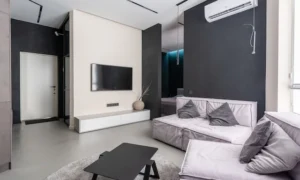Hospitality furniture plays a crucial role in creating a welcoming and comfortable environment for customers. Whether it’s a hotel, restaurant, or café, the furniture used in these establishments can greatly impact the overall experience of patrons. It not only provides a place for customers to sit and relax but also contributes to the aesthetic and brand image of the business. In this article, we will explore the importance of hospitality furniture in business and how updating it can have a positive impact on customer experience and overall success.
The Impact of Outdated Furniture on Customer Experience
Outdated furniture can make a business look uninviting and unprofessional. When customers walk into an establishment and see worn-out chairs, chipped tables, or faded upholstery, it can create a negative first impression. This can lead to customers questioning the cleanliness and quality of the business as a whole. Additionally, outdated furniture may not be as comfortable or functional as newer options, leading to discomfort and dissatisfaction among customers. If customers are not comfortable during their visit, they are less likely to stay longer or return in the future.
The Benefits of Updating Hospitality Furniture
Updating hospitality furniture can have numerous benefits for businesses. Firstly, it can improve the overall customer experience and satisfaction. By providing comfortable and aesthetically pleasing furniture, businesses can create a welcoming environment that encourages customers to stay longer and enjoy their time. This can lead to increased customer loyalty and positive word-of-mouth recommendations. Additionally, updating furniture can attract new customers who are drawn to the modern and stylish atmosphere created by the new furnishings.
Furthermore, updating hospitality furniture can enhance the brand image of a business. The furniture used in an establishment contributes to its overall aesthetic and can help create a cohesive and branded look. For example, a high-end hotel may opt for luxurious and elegant furniture to convey a sense of luxury and sophistication. On the other hand, a trendy café may choose more contemporary and colorful furniture to create a vibrant and youthful atmosphere. By carefully selecting furniture that aligns with the brand image, businesses can strengthen their identity and attract customers who resonate with their style.
How to Choose the Right Furniture for Your Business
When choosing furniture for your business, there are several factors to consider. Firstly, think about the style and aesthetic of your establishment. The furniture should complement the overall theme and design of the space. For example, if your business has a rustic and cozy atmosphere, you may opt for wooden furniture with warm tones. On the other hand, if your business has a modern and minimalist design, you may choose sleek and streamlined furniture in neutral colors.
Secondly, consider the functionality and comfort of the furniture. It’s important to choose furniture that is suitable for the intended use. For example, if you run a restaurant, you may need chairs that are stackable for easy storage and tables that can accommodate different party sizes. Additionally, prioritize comfort to ensure that customers can relax and enjoy their time in your establishment. Consider factors such as cushioning, ergonomics, and back support when selecting seating options.
Lastly, take into account the durability and maintenance requirements of the furniture. Hospitality furniture is subjected to heavy use and may be exposed to spills, stains, and wear and tear. Therefore, it’s important to choose furniture that is durable and easy to clean. Look for materials that are stain-resistant and can withstand frequent cleaning without losing their quality. Additionally, consider the maintenance requirements of the furniture to ensure that it can be easily maintained without incurring excessive costs or effort.
The Role of Color and Design in Hospitality Furniture
Color and design play a significant role in hospitality furniture as they can impact the overall atmosphere and mood of a space. Different colors evoke different emotions and can create a specific ambiance. For example, warm colors such as reds and oranges can create a cozy and inviting atmosphere, while cool colors such as blues and greens can create a calming and relaxing environment. Consider the desired atmosphere of your establishment and choose colors that align with that vision.
In addition to color, the design of the furniture can also contribute to the overall aesthetic of the space. The design should be cohesive with the overall theme and style of the establishment. For example, if your business has a vintage theme, you may opt for furniture with ornate details and antique finishes. On the other hand, if your business has a contemporary design, you may choose furniture with clean lines and minimalist features. By carefully selecting furniture that aligns with the desired aesthetic, businesses can create a cohesive and visually appealing space.
The Importance of Comfort and Functionality in Hospitality Furniture
Comfort and functionality are key factors in creating a positive customer experience. When customers visit a hotel, restaurant, or café, they expect to be able to relax and enjoy their time. Uncomfortable seating or poorly designed furniture can lead to discomfort and dissatisfaction among customers. This can result in shorter visits, negative reviews, and decreased customer loyalty.
Additionally, the functionality of the furniture is crucial in ensuring a smooth and efficient operation. For example, in a restaurant, tables should be sturdy and stable to prevent spills or accidents. Chairs should be easy to move and stack for efficient cleaning and storage. By choosing furniture that is comfortable and functional, businesses can create an environment that is conducive to both customer satisfaction and operational efficiency.
Sustainability and Eco-Friendly Options in Hospitality Furniture
In recent years, there has been a growing emphasis on sustainability and eco-friendly practices in various industries, including hospitality. Choosing sustainable and eco-friendly furniture can have a positive impact on the environment and appeal to customers who prioritize sustainability. There are several options available for businesses looking to incorporate sustainable practices into their furniture choices.
One option is to choose furniture made from recycled or reclaimed materials. This can include furniture made from recycled wood, plastic, or metal. By using materials that have been repurposed, businesses can reduce their carbon footprint and contribute to the circular economy. Additionally, businesses can opt for furniture made from sustainable materials such as bamboo or cork, which are renewable and have a lower environmental impact compared to traditional materials.
Another option is to choose furniture that is certified as environmentally friendly. There are various certifications and labels that indicate the sustainability of a product, such as the Forest Stewardship Council (FSC) certification for wood products or the Global Organic Textile Standard (GOTS) certification for textiles. By choosing furniture with these certifications, businesses can ensure that they are supporting ethical and sustainable practices.
How to Budget for Updating Your Hospitality Furniture
Updating hospitality furniture can be a significant investment for businesses, and it’s important to budget accordingly. Firstly, consider the cost of the furniture itself. Research different suppliers and compare prices to ensure that you are getting the best value for your money. Keep in mind that higher-quality furniture may come with a higher price tag but can also offer better durability and longevity.
In addition to the cost of the furniture, consider any additional expenses such as delivery and installation. Some suppliers may offer free delivery or installation services, while others may charge additional fees. Factor in these costs when budgeting for your furniture updates.
If the upfront cost of updating all your furniture is too high, consider phasing in updates over time. Prioritize the areas or pieces of furniture that are most in need of replacement and allocate your budget accordingly. This allows you to spread out the cost over a longer period and make more manageable payments.
Lastly, consider financing options if necessary. Some suppliers may offer financing plans or leasing options that allow you to pay for the furniture over time. This can help alleviate the financial burden of updating your furniture all at once.
Tips for Maintaining and Caring for Your New Furniture
Once you have invested in new hospitality furniture, it’s important to properly maintain and care for it to ensure its longevity. Regular cleaning and maintenance can help extend the lifespan of your furniture and keep it looking its best. Here are some tips for maintaining and caring for your new furniture:
1. Follow the manufacturer’s instructions: Each piece of furniture may have specific care instructions provided by the manufacturer. Follow these instructions carefully to avoid damaging the furniture.
2. Clean regularly: Regularly clean your furniture to remove dust, dirt, and spills. Use a mild detergent or cleaning solution that is suitable for the material of your furniture. Avoid using harsh chemicals or abrasive cleaners that can damage the surface.
3. Protect from sunlight: Direct sunlight can cause fading and discoloration of furniture upholstery and finishes. Use curtains, blinds, or UV-protective window films to minimize exposure to sunlight.
4. Use protective covers or treatments: Consider investing in protective covers or treatments to prevent damage to your furniture. For example, you can use fabric protectors to repel stains or apply wood polish to maintain the shine and condition of wooden furniture.
5. Address repairs promptly: If you notice any damage or wear and tear on your furniture, address repairs promptly. This can prevent further damage and extend the lifespan of your furniture.








































